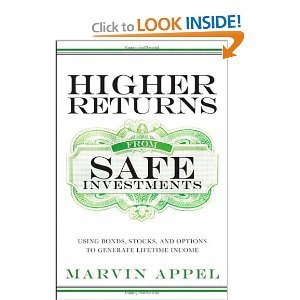
This isn’t another book of “buy a bunch of stocks, hold them for 30 years, and hope for the best” type of investment advice. “Higher Returns from Safe Investments: Using Bonds, Stocks, and Options to Generate Lifetime Income” by Marvin Appel delivers an alternative perspective on the risks and returns from other types of investments; namely bonds. However, he doesn’t just stop there. The book also covers a broad range of other under-appreciated investments such as high-dividend stocks, preferred stocks, and covered call options.
I’ll be the first to admit: There is nothing sexy about reading a book about bonds. But after experiencing the evaporation of money during the Great Recession of 2008, I think a book with this sort of title deserves its due time.
The significance of bonds is usually trivialized in most investment books. In general, they are usually portrayed as being unattractive because their returns don’t come close to that of stocks (less than 10%). Most books just portray them as being this ultra-safe addition to the portfolio. I was surprised by the way that Dr. Appel dismisses this myth as he reviews all the various types and drawbacks of certain bonds.
Summary:
The focus of this book is building a portfolio you can rely on for “guaranteed” returns. More or less, he’s seeking to build the ideal portfolio for not just a retiree, but for anyone looking for a safer place to put their money than just the general stock market. Appel lays out the options and then spends each chapter explaining (in great detail) the technical aspects of each product.
Near the end of the book, Dr. Appel finally lays out his suggested “safe” portfolio:
• 10% High dividend stocks (ETF: SDY)
• 5% High dividend emerging market stocks (ETF: DEM)
• 10% covered call writing (or ETF: PBP)
• 10% preferred stocks (or ETF: PFF)
• 25% high yield bond funds (using a “Stop Loss” technique to control risk)
• 40% investment grade bonds
Other Things I Learned From This Book:
One interesting strategy Dr. Appel highlights is the use of Bond Ladders in Chapter 4 (p. 45). Similar to CD ladders, a bond ladder is structured such that a series of principal investments comes due every year (or two years). For the most part, the sets that have longer maturity durations will also have higher interest rates. As each set of principal (your original purchase) matures, the principal is then reinvested at a new (and hopefully higher interest rate) so that the process continues. The result is that this strategy allows the investor to lock into the highest interest rates available with very little risk.
Another appealing skill that Dr. Appel explained was in Chapter 7 and was called the “Stop Loss” technique (p. 84). This method involves the investor buying a bond mutual fund and then monitoring it every so often (such as once a week or month). As the fund rises, no action is required. If the fund drops by more than 3% of its peak, then you sell the investment and hold the cash in your broker account. You again continue to monitor the fund until it climbs upward at 3% off its lowest value. When this occurs, you re-purchase the fund. The point of this strategy is to keep all the gains when the fund is at a peak and to hold on the investment when the market starts to dip (as it did by 30-40% in 2007-2008). Please note this strategy only works for bond mutual funds which generally move slower than stock mutual funds or stocks themselves. In addition, this tactic only works so long as there are no buy/sell fees for the mutual fund.
More On Asset Allocation:
Since I like collecting various opinions on asset allocation, I thought this section was helpful.
In Chapter 10 on p. 135, Dr. Appel displays a table that presents various portfolios composed of stocks and bonds in increments of 25%. The table contains two key figures: 1) % gain and 2) % “drawdown” (a period of high to low; think of it as the worst of your losses). Interestingly enough, the data suggests that:
• There is a 1.5% annual gain spread between a portfolio of all stocks or all bonds
• The composition with the least “Worst Drawdown” is one of 75% bonds and 25% stocks with a –12% drawdown (vs. –13% for all bonds and –51% for all stocks).
• Therefore, one of the safest and best returning portfolios is one of 75% bonds and 25% stocks.
Note the data was for 1976-2008 and compared the S&P 500 Index (with dividends) and Barclay’s Capital U.S. Aggregate Bond Index (with interest).
Final Thoughts:
If you want a safer portfolio, you have to learn about more than just stocks. Adding bonds and other alternatives to your portfolio might not give you stellar +10% returns, but it might just be your best hedge against +10% falls.



The 50/50 investing plan is a game changer for my investment plan. I looked at the results of the breakdown and its dam good. Thats is what im using in my 457 deferred comp plan at work.